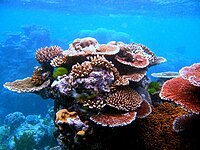
Photo from wikipedia
Abstract The Vibrionaceae are Gram-negative bacteria present in marine and estuarine environments worldwide, including several species known as important pathogens to humans and aquatic organisms. The aim of this research… Click to show full abstract
Abstract The Vibrionaceae are Gram-negative bacteria present in marine and estuarine environments worldwide, including several species known as important pathogens to humans and aquatic organisms. The aim of this research was to investigate the occurrence and virulence properties of Vibrio and Salinivibrio isolated from lagoons at Cuare Wildlife Refuge and Margarita Island in the southern Caribbean Sea. Water, plankton and oyster samples were collected during October 2011 and March 2012 and examined by specific PCR and culture methods. Vibrio genus DNA was detected in 95% of samples, while the intergenic spacer region (ISR) of Vibrio cholerae and the genes that code for the thermolabile direct haemolysin (tl) of Vibrio parahaemolyticus and the haemolysin/cytolysin (vvhA) of Vibrio vulnificus were absent or amplified in low proportions (23, 5, and 0%, respectively). Nine isolates from water and plankton were confirmed as Vibrio or Salinivibrio by phenotypic tests, 16S rRNA gene sequencing and phylogenetic analysis. All the isolates presented similar patterns of virulence factors, in which the genes ctxA (encoding for cholera toxin), tl and vvhA were lacking, whereas seven isolates displayed antibiotic resistance against ampicillin and cephalosporins. The 16S rRNA phylogenetic analysis showed the clustering of Vibrio isolates in three main clades: the plankton isolate from Cuare Wildlife Refuge formed a group with V. cholerae and Vibrio mimicus while the Margarita isolates clustered with sequences from the harveyi clade and Salinivibrio. This is the first time that Salinivibrio species are reported in tropical lagoons of the Caribbean Sea with antibiotic resistance.
Journal Title: Antonie van Leeuwenhoek
Year Published: 2017
Link to full text (if available)
Share on Social Media: Sign Up to like & get
recommendations!